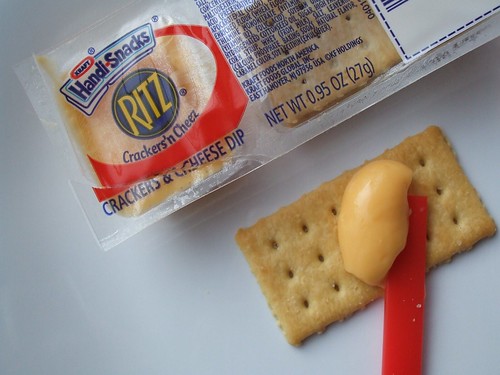
Children of the 90s note: I don't want to hear it from any of you naysayers that Trapper Keepers belong to 80s children. Can't we share? Many of us 80s babies were 90s children, you know, and we loved our Trapper Keepers with every bit the same ardor as you did. Case closed. With velcro, no less. That stuff sticks.
There's nothing like overpriced school supplies to give kids an unneeded boost of self importance. Really, anybody who was anybody had a Trapper Keeper. Well, anybody who was anybody aged five to fifteen who grew up during the 80s and 90s. I highly doubt any high powered lawyers were toting around a Ninja Turtles-themed binder in their briefcases.
School supply shopping is always an ordeal, but Mead stepped in and gave us a few more things worthy of our throwing ourselves tantrum-style on the floor in the middle of OfficeMax. These things were more than worth completely humiliating our parents in a highly public place if only it meant that we would soon be toting a Trapper Keeper full of coordinating folders in our backpack.
Buying designer-esque school supplies was the only reason to get excited for going back to school in the fall. Picking out each shiny folder, the multicolored pens, and best of all our very own brand-spanking new Trapper Keeper complete with Velcro closure sporting our favorite design or character on the front. They may have been five bucks at the store, but the market value amongst children was off the charts.
This is probably the quintessential late 80s/early 90s school supply commercial. The humor is so cheesy they might as well package it with crackers and call it a Handi-Snack
It was the ultimate status symbol for a kid reentering the school year. God help you if you started at a new school and were caught unaware of the fact that Lisa Frank ballerina bunnies or Sonic the Hedgehog were the only designs to have. Those with the lesser abstract-patterned Trapper Keepers were left to wallow in their quiet school supply induced shame, kicking themselves for coveting the paint splattered cover in lieu of the more contemporary character designs.
Trapper Keepers were the ultimate school accessory and supposedly taught us organizational skills from a young age, though mine was always bursting at the seams with untidy clutter. They were generally pretty functional as far as elementary school supplies go, giving our parents less of a reason to veto their purchase on that all-important back to school shopping trip. They typically featured specially fitted folders, a handy pencil case, and a wraparound closure to encase all of our schoolwork in a neat little package. Don't even get me started on the satisfying sound of pulling open the Velcro tab. These babies were nothing short of a kid's dream.
Now in an age where kids are now sporting actual designer school supplies (Louis Vuitton pencil cases, anyone?) it's almost laughable to reminisce about a time when a run-of-the-mill product available for a few bucks at WalMart commanded respect and awe from our classmates. Kids these days (using this phrase is the first sign of adulthood) with their iPhones and Ed Hardy tee shirts are unlikely to appreciate the value of a simple pleasure like a Trapper Keeper. We, on the other hand, knew their worth. You know, as our Trapper Keepers had to keep our papers in order as we trudged to school on foot. In the snow. Uphill both ways.

In any given classroom during the 80s and 90s there were undoubtedly a vast spectrum of designs and styles on display. Trapper Keepers were all for gender stereotyping, offering typical boy- and girl-specific fare. For the girls, we had our dolphins, our kittens, our puppies, and all other types of aww-inspiring images to nicely complement our burgeoning sticker collections. For the boys, we had video game themes, sports team logos, masculine cartoon characters, cars, or extreme sports-type designs. Sure, there were crossover abstract designs that were pretty gender neutral, but dammit if I wasn't going to get a kitty cover like the rest of my female classmates.
These homework holders may seem benign, but mischievous kids were always able to find ways to provoke school administrators into banning these covetable caches. With a bit of destructive disassemblage, we could easy build desktop self-enclosing Trapper Keeper cubicles behind which to write notes, play with contraband Silly Putty, and engage in other banned activities. Other schools considered the binders to be more of a distraction than they were worth and because they created unnecessary class distinctions. All over something you could purchase all Wal-Mart, no less. Those were the good old days.

Nowadays, you can find Trapper Keepers again stocked in store shelves but they're certainly a different model than the ones we so craved. The satisfying sound of pulled Velcro is no more, as the new TKs feature a quieter, more demure magnetic closure. They have customizable covers under which you can slide your own photos or design. Heck, they don't even come with the signature Trapper folders, which have since been replaced with bland dividers. Maybe I'm reading into it a bit too far, but wouldn't that make it just a Keeper? I'm about to cry false advertising.
To make matters worse, a couple of years ago Mead released a model that would play music from your iPod. Really? What has this come to? I was happy just to have a picture of a panda doing some housepainting on the cover. Now these kids are using them as speaker systems? What exactly is this world coming to where a kid can't enjoy a simple school supply simply on the merit of its design alone? These kids can have their crappy new models. I'm digging up my old Lisa Frank prototype. At least then I can remember Trapper Keepers for the way they were.
Check it out:
The Surfing Pizza's Ode to Trapper Keepers











